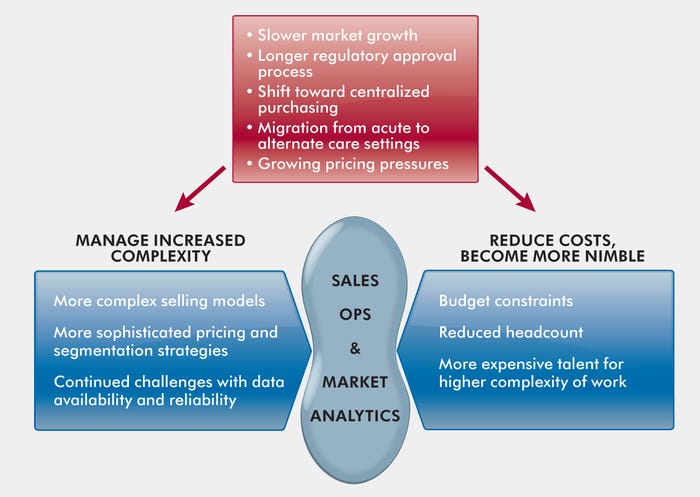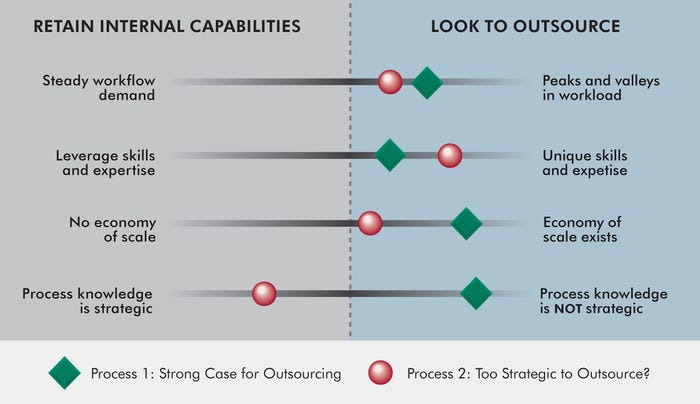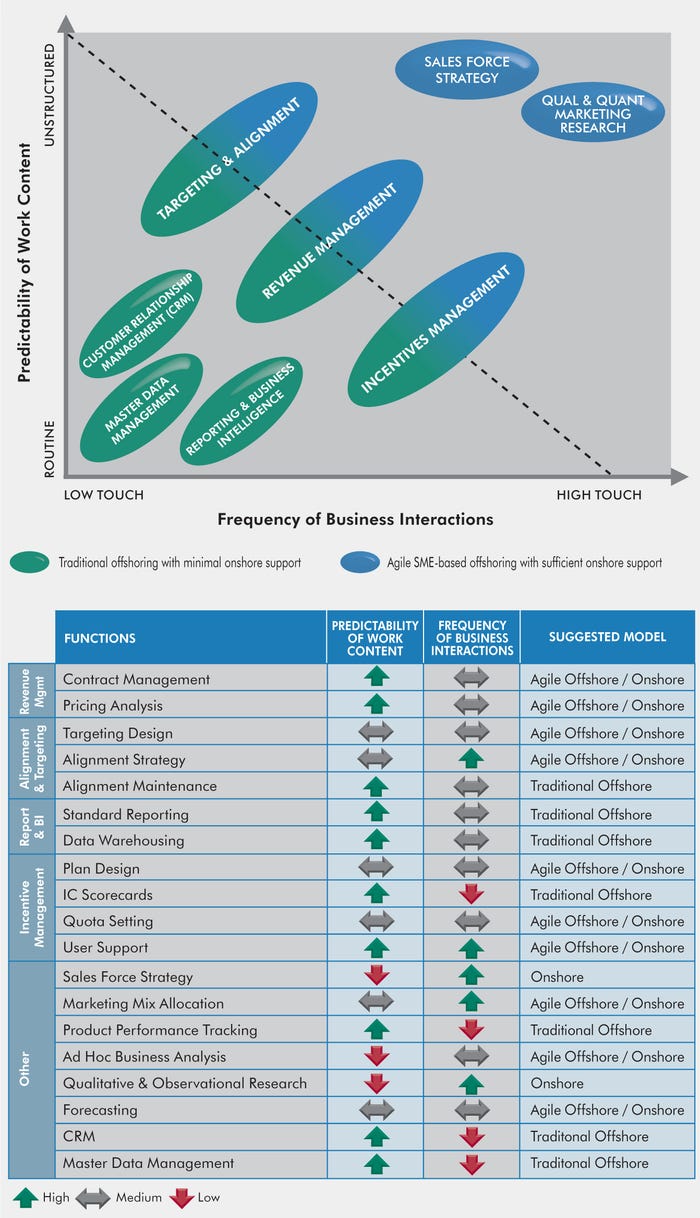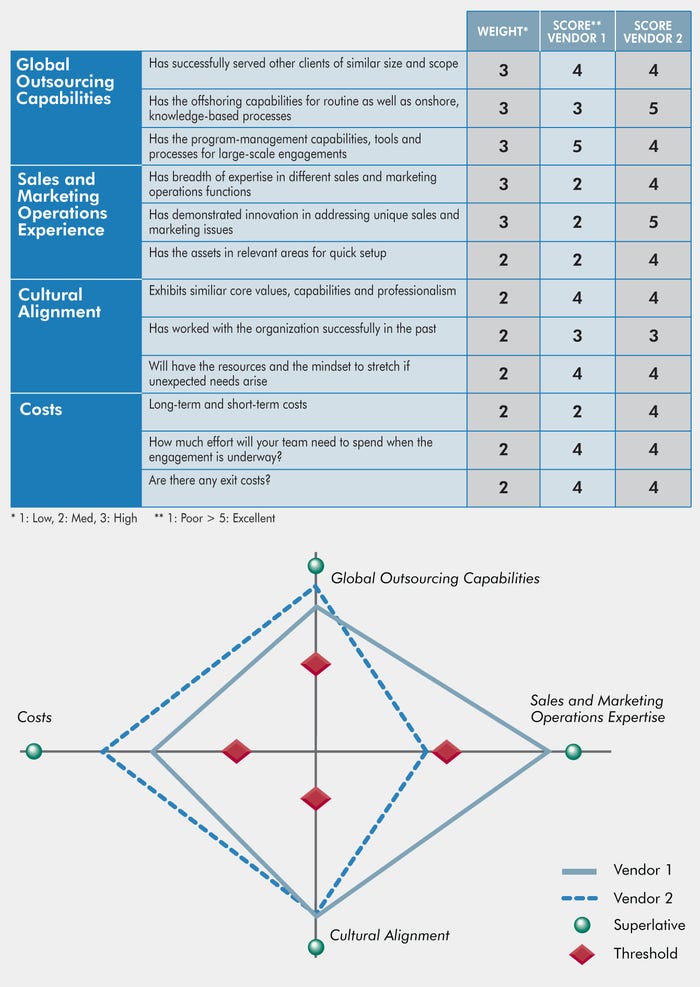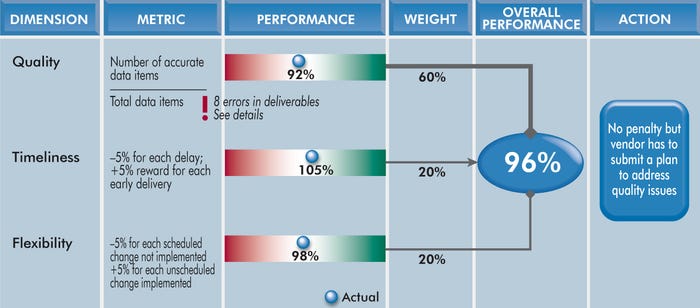Global Outsourcing for Medical Sales and Marketing
|
Figure 1. [Click to enlarge] Gauging sales and marketing operations in an outsourcing model. |
Medical device companies have been under significant pressure to pare costs and increase revenue growth. In an environment of increasing competition, greater price pressures, lackluster market growth and a challenging FDA, marketing and sales organizations often struggle to drive growth. Marketing and sales functions have been challenged to elevate their ability to add value. At the same time, however, fewer funds are available. Global outsourcing of marketing and sales analytic processes can address the do-more-with-less challenge.
Many companies are discovering that global outsourcing offers a unique promise of improving both a company’s effectiveness and efficiency. However, some firms may see the potential benefits from global outsourcing, but they may not be sure under which circumstances it should be used. In addition, they may be concerned about relinquishing control of key processes as well the potential risks of a poorly implemented program that does not meet their unique business needs. This article presents a framework for identifying areas in which medical product companies can benefit from global outsourcing of sales and marketing analytics support. It also discusses the key factors in ensuring a successful program.
More Complexity, Fewer Resources
Issues endemic to the medical device industry—slowing growth, increased competition, heightened regulatory scrutiny and pressure on pricing—are forcing companies to consider new ways of doing business. In their quest for efficiency, companies are evaluating new sales models that are less costly. Some examples include new roles such as telesales, clinical specialists, junior reps, sales assistants, or greater use of key account managers who carry products from multiple company divisions and call on IDN buyers and senior executives from customers. The implementation of these new selling models often requires sales operations and analytics groups to adapt and deal with greater complexity in areas such as field force alignment, pricing and contracting, incentive compensation, and reporting, among others.
Although sales and marketing operations require additional effort and innovation to support new, more-complex selling models, they must do so with fewer resources due to cost-cutting pressures in the industry (see Figure 1). Furthermore, many of these support functions require sophisticated analytical support to ensure their effectiveness, which is difficult to implement when there are constraints on resources. To help solve this dilemma, companies are taking advantage of outsourcing to both gain access to sophisticated best practices and, at the same time, keep labor costs low. Moreover, firms are using third parties because they typically lack the scale to build their own platform overseas. This trend is referred to as global outsourcing, as it is different from domestic outsourcing operations or operations that the device company owns and operates offshore.
|
Figure 2. [Click to enlarge] Common criteria for determining whether to outsource a given business function. |
Even though global outsourcing can play a critical role in doing more with less, companies’ experiences with this practice are varied. Some companies have enjoyed nimble service and low costs, but others have come away as dissatisfied stakeholders due to low quality and poor responsiveness, and have not realized cost savings. So what separates the successes from failures? In the authors’ experience, global outsourcing is most successful when an outsourcing partner’s expertise and innovation are combined with the cost savings of a global operation. Not only is it important to outline what makes a global outsourcing operation successful, but doing so requires thoughtful planning and an understanding of subtle factors that are critical to success.
The Key Factors for Global Outsourcing Success
An effective global outsourcing initiative encompasses several key factors, including the following:
? Selecting the right business processes to outsource and defining success clearly.
? Choosing the right operating model, recognizing that a one-size-fits-all model will not serve different support functions.
? Picking partners that are aligned with the overall scope and objectives of the project.
? Establishing an appropriate performance management and tracking process, embodied in service-level agreements (SLAs).
? Developing a workable transition process.
Selecting the Right Business Processes to Outsource and Defining Success Clearly
It is critical to select the right business processes to outsource. Although there are common criteria in outsourcing a business process, some of the criteria are specific to a company’s culture and philosophy. Figure 2 illustrates some of these common criteria for deciding whether to outsource a given business function. For instance, when there are peaks and valleys in the workload, a vendor has the flexibility to redeploy resources most efficiently, minimizing costs. (Such tasks are often associated with planning cycles, including sales force resource planning, quota setting, and target list updating.)
Economies of scale is another reason to outsource because some areas, such as data management, sales reporting, and alignment management, lend themselves to standardization. Companies may also choose outsourcing to access unique expertise.
However, highly strategic functions may need to be kept in house, even if they appear to be good outsourcing candidates otherwise. What is considered strategic may be company-specific—for example, one company may decide to not outsource its segmentation process because it thinks its segmentation strategy is a competitive advantage.
Finally, the organization needs to determine its readiness for outsourcing—no matter the potential, if a company is not ready for global outsourcing, it may not realize its benefits. In one example, a company that outsourced its ad hoc analysis and reporting functions did not account for the fact that users were accustomed to having their favorite analysts at their beck and call. When the company implemented a structured, outsourced system that did not have the same levels of access, users resisted, and this undermined the operation’s success.
The rationale for outsourcing also varies. For some sales and marketing groups, the key factor may be cost savings while adapting to peaks and valleys in demand; for others, it may be to improve the organization’s level of analytical capability. As obvious as establishing rationales might seem, it is not uncommon to see organizations fail to clearly define and communicate their outsourcing goals. Finding consensus for goals and communicating rationales and objectives are vital to ensuring consistency, as well as to ensuring that performance measurement criteria are defined appropriately.
Choosing The Right Operating Model
It is important to note that functions within sales and marketing operations include those that are unstructured as well as those that require a high degree of personal interaction (see Figure 3). In addition, the goal for each function may vary, whether it is greater cost efficiencies, better quality, or more innovation. This variance necessitates different global outsourcing models.
|
Figure 3. [Click to enlarge] Traditional versus agile outsourcing model. |
The variation in outsourcing models underscores the need to select the right one. And it is just as important to understand that the traditional offshoring model—which relies on standardized processes and detailed specifications that enable well-defined work in remote locations—may not be universally appropriate. Jobs such as standard report development and production are well suited for traditional offshoring.
However, sales and marketing support functions often require agile, knowledge-based offshoring capabilities, supplemented by appropriate on-site support. These functions have rapidly changing business conditions, and the work may require specialized subject matter expertise. The goals can be amorphous and the needs dynamic. Some functions also require a high-touch environment with stakeholders.
It is worth noting that within a single business function, tasks may vary in their support requirements. For example, within incentive management, tasks such as scorecard generation are suited to traditional offshoring. Other tasks, such as quota setting or incentive compensation support, require agile, knowledge-based resources.
In short, the right work model must be assigned to each function. Selecting vendors that apply traditional offshoring models to knowledge-based tasks results in quality deficiencies, while choosing those that apply the agile model to routine tasks results in unwarranted complexities and costs.
Naturally, that leads to a question and determinant of global outsourcing success: How does a medical product sales and marketing organization select the right partners?
Selecting the Right Partners
Companies tend to want fewer, rather than more, global outsourcing partners. Although the diverse needs of different business processes may suggest the need for multiple best-of-breed partners, there are major difficulties in coordinating multiple partners and maintaining clear accountability. As a result, it becomes critical to select partners that have the ability to support multiple business functions.
In evaluating a potential partner’s abilities, a company needs to consider multiple criteria, such as the potential partner’s experience with large outsourcing engagements, its breadth and depth of expertise, its ability to integrate different types of offshore models, and the vendor’s overall cost. Figure 4 illustrates sample evaluation metrics to evaluate potential partners.
|
Figure 4. [Click to enlarge] Sample evaluation of potential partners based on four primary metrics. |
Partner evaluation goes beyond a facile inspection—there needs to be a good cultural match between the global outsourcing partner and client, which entails similarities in values and responsiveness. In one case of a large outsourcing engagement, a client quickly reacted to the business needs, whereas the vendor had a structured, bureaucratic culture of working within the contractual domain of SLAs. Despite the vendor meeting terms of the agreement with the client, its lack of empathy for the client’s sense of urgency undermined the service. The bottom half of Figure 4 illustrates how possible partners might be evaluated on key factors. In this example, Vendor 1 may be better at providing a wide spectrum of outsourced business functions due to its high score on expertise and other dimensions. Vendor 2 would have been a marginally better choice if the engagement included only routine tasks.
Establishing SLAs
Once a company selects an outsourcing partner, during the contracting process it is important to translate overall engagement objectives into specific and quantifiable goals. Such goals may include cost-reduction targets, quality improvement measures, cycle time reduction, or improved response time. Without specific measurable metrics, anecdotes and bias can skew perceptions of the partner’s true performance.
SLAs can help avoid such bias. These agreements define measurable goals and track performance, as well as help define appropriate actions when the vendor is not meeting its responsibilities. Figure 5 shows an example of SLA metrics and how two vendors might compare in terms of performance. Although it is common to include penalties for failing to perform at the expected level, it is also important to include incentives that promote performance.
|
Figure 5. [Click to enlarge] An example vendor performance evaluation. |
Developing a Transition Strategy
Finally, a company that has decided to outsource support functions must not underestimate the scope of management and planning activities needed for an effective transition. For example, a company may prefer to make a quick transition if it wants to keep employees motivated for an extended period of time. Conversely, deliberation may be more appropriate when a company needs the time to question or improve legacy processes.
Transitions are difficult and often pose personnel disruptions. It is critical to focus on systematic execution and appropriate governance throughout the process. It pays to heed simple tasks such as creating a glossary of terms that are part of an organization’s vocabulary, and investing in tools to capture knowledge systematically. The company can establish a transition management office with appropriate executive sponsorship to ensure oversight. Besides ensuring the right level of focus, this office can conduct periodic audits to see if different stakeholders’ needs are being met.
Conclusion
Global outsourcing is not a panacea, but it can help sales and marketing support organizations do more with less. Properly structured global outsourcing programs can result in lower costs and greater flexibility and innovation. But this requires a structured, step-by-step approach. Medtech executives considering global outsourcing need to have the proper mindset before embarking on a program. They need to reconsider any preconceived notions about outsourcing, shunting a blanket approach in which everything is outsourced in favor of a selective, discriminating view in which only certain processes are outsourced.
With well-defined objectives, the right partner and functions, as well as proper measurements of success in the form of SLAs, medical device companies’ sales and marketing operations can be more flexible and innovative than before and costs can be kept low.
Pete Masloski leads ZS Associates’ (Evanston, IL) medical products and services practice. Dharmendra Sahay and Bret Caldwell are principals at the firm.
About the Author(s)
You May Also Like
